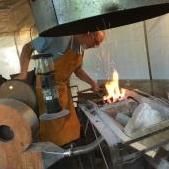
Winegums
Members-
Posts
13 -
Joined
-
Last visited
-
I learned a lot trying to forge tongs to be honest, and looking back on it every failure was a lesson. Drawing out, offsetting, upsetting, punching/slitting, measuring, rounding, etc. It really got me familiar with all the basic operations of smithing. I learn by doing and found that I couldn't forge efficiently with pliers and vise grips. I knew that I needed tongs and when I looked at the price of them it was too much for my liking. Tongs were the first real tool I ever made and have since used my smithing to make custom wood working tools for myself as well. Maybe I'm an anomaly? I love making tools, maybe more than making things with the tools.
-
Agreed, If you can't hold the piece solid and keep it in control, Don't forge. You can't do good work when your piece is moving around or threatening to slip out of the tongs.
-
That reminds me of this video. For some reason that big flat stone looks beautiful to me as a tool.
-
It's kinda neat that the side pockets are still visible on the front edge. Makes for good conversation when someone asks about my hobby smithy.
-
I used the slate from a 6' x 12' pool table for my small work area. Since it rains so much around here it wouldn't be practical to have a dirt floor that turns to mud on me.
-
Mild steel is better than an ASO IMO. My parents bought me one as a "gift", and it ended up a dented mess less than a few weeks later. It was a waste of money and time to use when the small puck of 4145 I had at the time was much more effective. I was patient and eventually found a 1-3-7 weight Peter Wright for $60.
-
I agree on both matters. The first thing I learned when I was making knives is that the right tongs are crucial. There's nothing worse than having a glowing hot piece of metal flying 6+ feet up in the air. I've found that Box Jaw tongs are the tool for the job when it comes to holding thin knife blades since the piece cannot escape from the sides. I make a Y shape by upsetting the bar for the tong for about 1 1/2" then split it down the end, to make something more like claws in a T shape than the traditional shovel shape. I found that the corners of the shovel shape were always tearing and didn't have enough meat for heavy forging 7/8" x 1/2" O1 flat stock that I use. Rather than buying the tongs for $50-60 + shipping, the OP could get $20 worth of mild steel, (or salvage it from a scrap yard), and make 10 pairs of tongs. My first projects were making tongs and I'm always wanting more and more of them. The best part about being a smith is that you can make your own tools, with only an anvil, hammer and fire.
-
D2 is demi stainless (12% Cr) with better corrosion resistance than 10XX, O1, W1, W2, A2 and other high carbon low chromium steels. It makes a good knife, (cold) punch/chisel, forming dies, etc. It's basically an air hardening tool steel that is less prone to rusting than say O1 which will stain if you leave so much as a finger print on it when it's bare.
- 20 replies
-
- tools
- air hardening
-
(and 1 more)
Tagged with:
-
I have a rectangular stainless steel fire extinguisher box lined with fire bricks. There's nothing holding the pieces together which allows for easy cleaning and rebuilding of the forge for different projects. Just be wary that bricks will crack and erode when exposed to very high temperatures and need to be replaced regularly.
- 8 replies
-
- fire pot
- coal forge
-
(and 1 more)
Tagged with:
-
Removable fasteners and parts that are keyed together are have the big advantage of being separated if necessary. Welding, Rivets and Glue have the disadvantage of permanently affixing things together and are not intended to easily come apart in most applications.
-
keep my charcoal in a 10 gallon metal paint bucket and smash it with the pointy end of a sheet metal hammer. I tend to shake my charcoal into the forge from the bucket so the large pieces rise to the top. Between forging pieces I go after the larger pieces and never seem to have too much mess to clean up since it's all contained.
-
I use a $9.99 walmart hair drier as my air source, it even has three air speeds so that I can idle my forge while I'm working a piece or bump up the temperature. I really don't see myself investing much more into my setup as a hobby blacksmith than that. If it breaks I replace it for cheap, which has only happened once 7 years I've been hammering on stuff. It's noisy but most things that move air are going to be noisy.
-
I did this when I wanted to get a feel for how metal moves when I was in my teens. Our wood stove always burned orange hot at the bottom when there was a good draft going and a bed of coals. I did precisely one project this way before I moved on to making my own custom charcoal forge for safety reasons and noise complaints from my family. Forging tends to spray extremely hot rust and sparks everywhere which is a major fire hazard as well. I highly recommend building a simple forge (outside) that uses charcoal if you want to get your feet wet.

